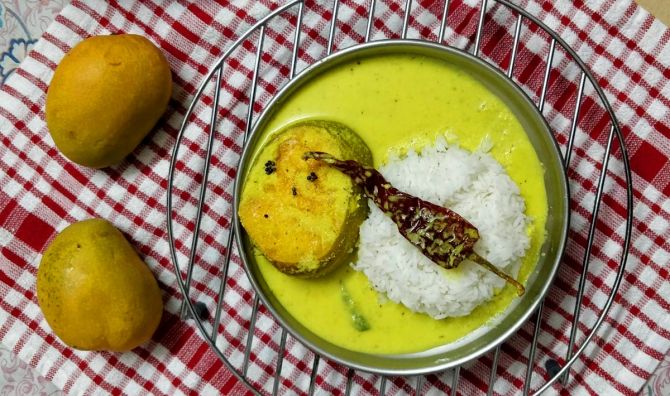Summers often remind me of the long vacations spent in my father's ancestral home in Thiruvilwamala, near Thrissur in central Kerala, surrounded by mango orchards and their over-ripe fruits, some half eaten by birds or squirrels, and plenty of them scattered on the ground.
Not a single day went by when we didn't have mangoes as part of our daily meal -- not just as fruit, we preserved and used them in pickles and jams as well.
The best memories -- even my siblings would agree -- would be fussing over 'What?! Again mambazha (mango) curry for lunch today?'
Because, mangoes, coconut and yoghurt were easily available, the watery mango curry or pachadi was almost a staple in our homes.
Years later, when I relocated to Maharashtra, post marriage, I found it hard to believe that people were willing to spend a fortune to buy organically grown mangoes, bananas and jackfruit.
The shopkeepers would sometimes plead and bargain to sell off their over-ripe mangoes and I would happily buy a couple of them.
Some of my non-Konkani, Maharashtrian neighbours were surprised to know that we could use over-ripe mangoes in curries accompanied by rice or rotis.
Even today, when I go back to visit my older aunts and uncles, I tease them 'Do you still make mambazha pachadi when you are too bored to cook? Do the grandchildren love it?' Their reaction, surprisingly, is still the same.
Love it or hate it, the sweet, juicy and flavourful mango curry is an altogether different emotion, especially if you have spent your childhood in Kerala. When you mix it with rice and mash the pulp using your hands, it brings back so many fond memories.
There may be slight variations in the preparation of this curry, depending on where you grew up and what ingredients were accessible. I am sharing a traditional vegetarian version of Mambazha Pachadi.
Seafood versions of this pachadi call for prawns.

Mambazha Pachadi
Serves: 4-5
Ingredients
- 2 ripe mangoes, washed and roughly sliced/chopped, preferably with skin on
- 1½ cups water + extra to grind the coconut paste
- 2 cups grated fresh coconut
- 2 tsp salt
- ½ tsp haldi or turmeric powder
- 3-4 green chillies
- ½ tsp mustard seeds, dry roasted
- 1 cup fresh yoghurt
- 2-3 stalks curry leaves
- Pinch jaggery or sugar, optional
For tempering
- 1 tsp coconut oil
- 1 tsp mustard seeds
- 1 tsp methi or fenugreek seeds
- Pinch hing or asafetida
- 2-3 red chillies
Method
- In a large kadhai, add the mangoes, water, salt, turmeric powder and bring this to a boil over medium heat -- you may add the curry leaves now to enhance the flavour.
- Meanwhile, in a blender/mixer, grind the coconut, green chillies, roasted mustard seeds, ½ cup of the yoghurt to a thick paste using minimum water.
Add the blended mixture to the mango mixture along with the remaining yoghurt, whisked.
Gently to mix all ingredients and bring it back to a simmer and then take off heat. - Add more salt, if required, and a pinch of jaggery/sugar and keep aside.
- In a tempering pan, heat 1 tsp coconut oil over medium heat and add the mustard seed, some of the curry leaves and the green chillies.
When they begin to splutter, add the asafetida, fenugreek seeds.
Fry on low heat and then pour on top of the mango mixture.
Cover to let the aroma and flavours blend in. - Serve hot with rice, appams or rotis.
Manjula's Note: Seafood lovers may prefer to add 10-12 medium-sized prawns that have been shelled, de-veined and tailed, while cooking the mango.












 © 2025
© 2025